
hotline:
17715390137
Tel/Wechat:
18101240246 (Technology)
0512-68565571
Email:mxenes@163.com (Sales Engineer)bkxc.bonnie@gmail.com
Scan the code to follow or search the official account on WeChat:
2D Materials Fronrier After paying attention,
click on the lower right corner to contact us,
Enter enterprise WeChat.
Professional Services Online

已传文件:photo/202036171859158.png
MXene-Conductive Polymer Asymmetric Chirped Capacitor
【Research Background】
Supercapacitors have attracted great interest due to their high power density, long cycle life, safe operation, wide temperature operating range, and low cost. Supercapacitors have broad application prospects, including hybrid electric vehicles, energy storage and regeneration, and the aerospace industry. Based on the charge storage mechanism of supercapacitors, supercapacitors can be divided into two categories: electric double layer capacitors (EDLC) and rhenium capacitors. Commercial supercapacitors are mainly EDLCs, which rely on the reversible electrostatic adsorption of ions at the electrode / electrolyte interface. Materials with high specific surface areas (such as porous carbon or graphene) are considered suitable for EDLC due to their low cost and high electron conductivity. However, the key challenge of EDLC is its low energy density. To overcome this problem, the use of rubidium capacitor materials that store charges through surface redox reactions has great potential. Conductive polymers (CPs) are typical pseudocapacitor materials. They exhibit high capacitance at a positive voltage in aqueous proton electrolytes. Asymmetric supercapacitors are assembled by using different negative electrodes, expanding their voltage window in aqueous electrolytes (thus increasing energy density).
[Achievement Profile]
In 2018, Professor Yury Gogotsi of Drexel University published a research paper titled: MXene—Conducting Polymer Asymmetric Pseudocapacitors in the internationally renowned academic journal Advanced Energy Materials. The article reported that 2D titanium carbide (Ti3C2Tx) General purpose pseudocapacitor negative electrode material, and a series of conductive polymers (CPs) deposited on reduced graphene oxide (rGO) sheet, such as polyaniline, polypyrrole and poly (3,4-ethylenedioxythiophene) Symmetric device. It can operate in voltage windows up to 1.45 V in 3M H2SO4 and shows excellent cycle performance, which is superior to many reported asymmetric chirped capacitors.
[Picture and text guide]
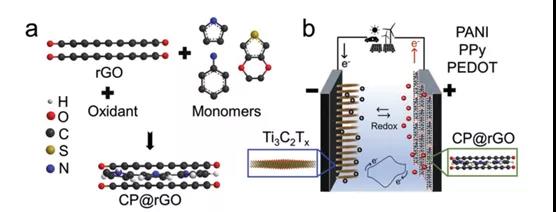
Figure 1. a) Schematic diagram of CP deposition on rGO nanosheets (CP @ rGO) b) Schematic diagram of asymmetric supercapacitors with organic-inorganic all-ceramic capacitor
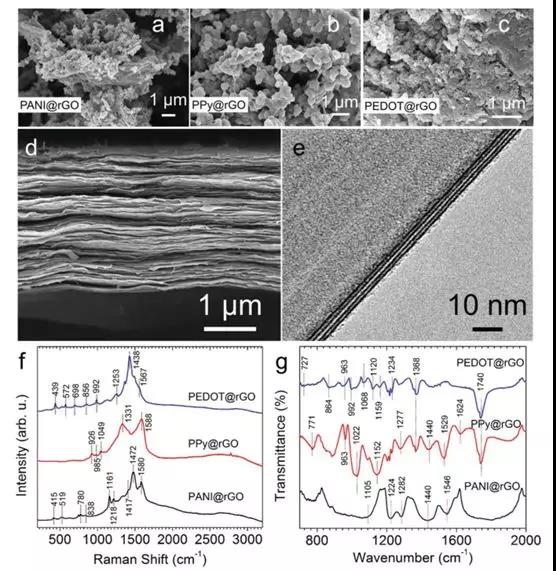
Figure 2. SEM images of a) PANI (PANI @ rGO), b) PPy (PPy @ rGO), and c) PEDOT (PEDOT @ rGO) deposited on rGO nanosheets. D) SEM image and e) TEM image showing the edges of MXene electrode f) Raman spectra of PANI @ rGO, PPy @ rGO and PEDOT @ rGO g) Corresponding FTIR spectra
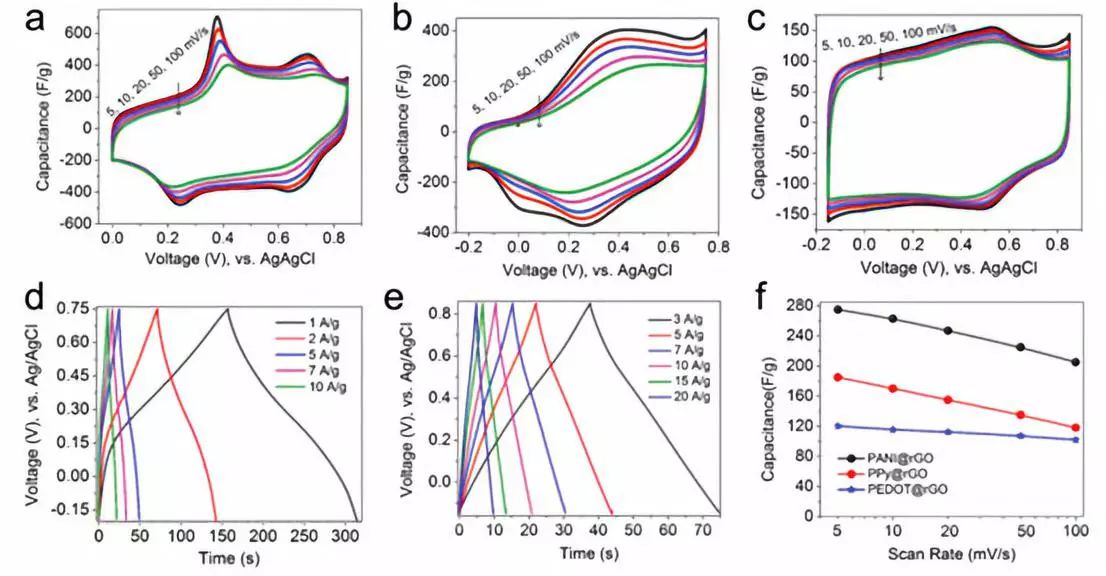
Figure 3. a) PANI (PANI @ rGO), b) PPy (PPy @ rGO), c) CV curve of PEDOT (PEDOT @ rGO), d) GCD curve of PEDOT @ rGO e) PPy @ GCD curve of rGO f) Corresponding rate performance
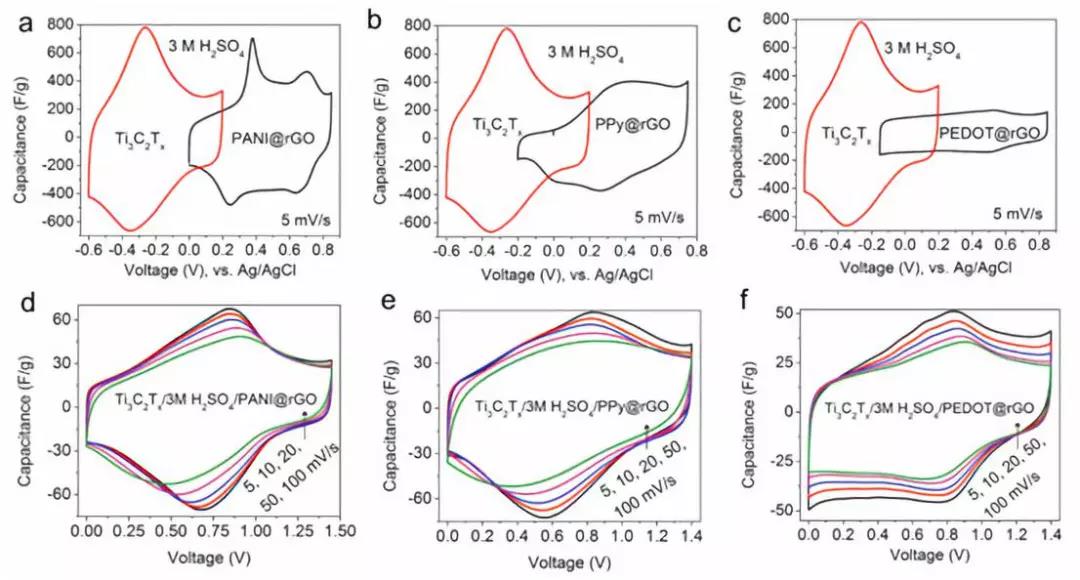
Figure 4. CV curve of a single electrode: a) compound containing a) PANI-, b) PPy-, c) PEDOT- and titanium carbide (Ti3C2Tx) d–f) Scan rate of the corresponding device at 5 to 100 mV s-1 CV curve

Figure 5. Charge storage mechanism in a fully chirped capacitive device
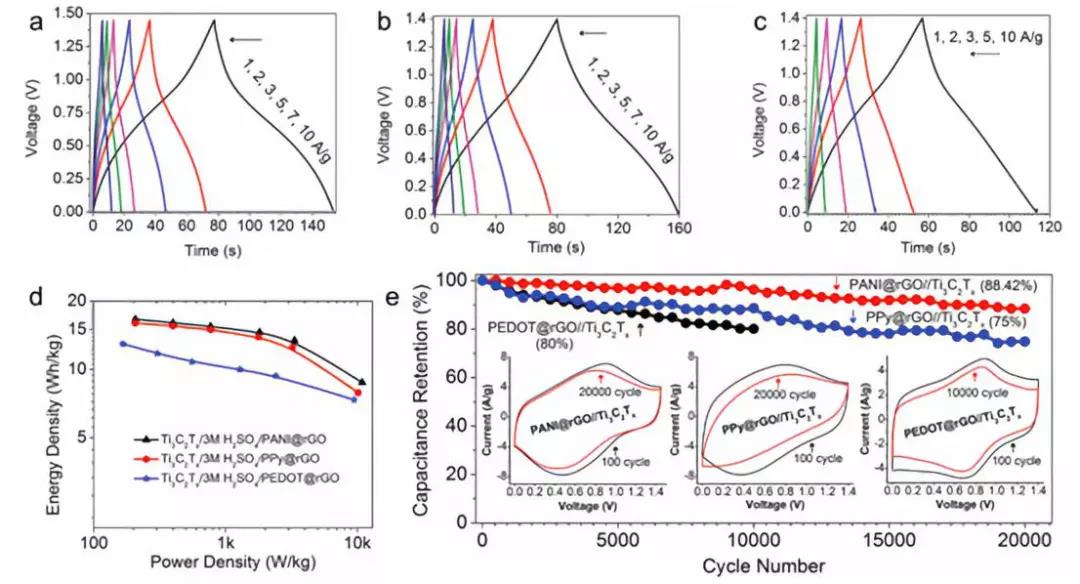
Figure 6. (a–c) GCD curves of PANI @ rGO // Ti3C2Tx, PPy @ rGO // Ti3C2Tx and PEDOT @ rGO // Ti3C2Tx devices. D) Corresponding energy comparison chart. E) Cycle life performance of the optimized composite. The internal graph is the CV curve of the device before and after a long cycle
[Summary of this article]
CPs exhibiting high pseudocapacitance at high positive voltages in aqueous proton electrolytes lack a pseudocapacitor negative electrode that matches them. The article confirms that conductive two-dimensional titanium carbide (Ti3C2Tx) can be used as a cathode material for different asymmetric supercapacitors containing CP. To demonstrate its versatility, we synthesized three CP-containing composites, namely PANI, PPy, and PEDOT, which were deposited on rGO nanosheets by oxidative polymerization and tested as positive electrodes. CP @ rGO // MXene‘s optimized composites exhibit high power, high energy density and excellent cycling performance. Asymmetric devices with PANI can operate in voltage ranges up to 1.45 V, provide high energy density ≈17Wh kg-1, and show an excellent capacitance retention of 88% after 20,000 cycles. This is based on PANI and is based on One of the highest capacitance retention rates in MXene‘s asymmetric devices. This article paves the way for the use of different nanostructured CP and MXene as negative and positive electrode materials to further improve the performance of energy storage equipment.
Literature link:
https://doi.org/10.1002/aenm.201802917

| Reminder: Beijing Beike New Material Technology Co., Ltd. supplies products only for scientific research, not for humans |
| All rights reserved © 2019 beijing beike new material Technology Co., Ltd 京ICP备16054715-2号 |